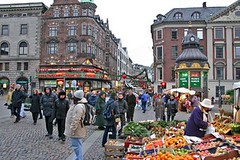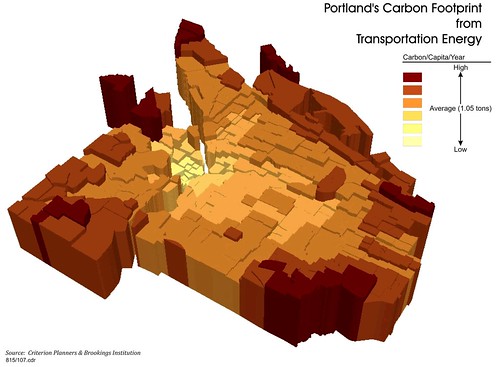Hey, Copenhagen: climate protection must include smart, walkable neighborhoods

Posted December 14, 2009 at 1:36PM
As the planet’s environmental movers and shakers convene to hammer out some form of agreement for reducing greenhouse gas emissions, however inadequate it is likely to be, at least they are lucky to be in one of the most walkable cities in the world. Copenhagen is a veritable model of human-scaled urbanism, with incredibly pleasant streets and neighborhoods where, it seems, almost no one needs a car to get around. If US metro regions, which as we know tend to be spread out and car-dependent, not to mention carbon-intensive, could pick up a few lessons from the Danish capital, we could forge a substantial reduction in our carbon footprint.
This, of course, has been one of the underlying themes of this blog. We know, for example, that Portland has actually reduced its aggregate carbon emissions since 1990 despite growing 18 percent in population, largely due to land-use and transportation strategies that stress infill locations, walkable neighborhoods, and transit-oriented development. Analysis graphically and dramatically captured by NRDC’s longtime collaborator Criterion Planners (see below) demonstrates that, the closer a household is to downtown, the lower its per-capita carbon emissions. The difference is largely due to the reduced vehicle trips and shorter driving distances afforded by smart growth. Portland planners and officials have taken that lesson to heart and grown their region accordingly.
Similarly, the Center for Clean Air Policy has concluded that smart land use and transportation choices can reduce the amount Americans need to drive - as measured in vehicle miles traveled (VMT) - by 10 percent per capita from 2005 levels. A 10 percent reduction in per capita VMT, says the Center, would reduce annual transportation emissions by 145 million metric tons of carbon dioxide (MMTCO2) in the year 2030, equivalent to the annual emissions of about 30 million cars or 35 large coal plants.
The ability of urbanism to reduce greenhouse gas emissions also became one of the main themes of David Owen’s much-heralded book,  Green Metropolis. When John Norquist refers to smarter neighborhoods as “the convenient remedy to the inconvenient truth,” he is right on point. (See also this post for a bunch of relevant data collected by John’s organization, the Congress for the New Urbanism.) So the word is getting out.
Green Metropolis. When John Norquist refers to smarter neighborhoods as “the convenient remedy to the inconvenient truth,” he is right on point. (See also this post for a bunch of relevant data collected by John’s organization, the Congress for the New Urbanism.) So the word is getting out.
But, to make sure, a number of experts and city leaders held a panel on the subject last week in Copenhagen. Ben Fried of WorldChanging did such a great job of reporting on the panel that I am simply going to lift a passage for you and point you to the source:
“At a panel discussion yesterday at the Copenhagen climate summit, American policymakers and transit experts delivered a clear message: Walkable urban development must be part of any effective plan to reduce global greenhouse gas emission . . .
“Without directing future development toward walkable urbanism, the climate impacts of sprawl will overwhelm other efforts to curb greenhouse gas emissions,
said Robert Cervero, a professor specializing in transportation and land use policy at UC Berkeley. ‘Urban development patterns have a significant role to play in carbon reduction,’ Cervero told the audience. ‘Otherwise we'll just get knocked back by land-use patterns. Sustainable urbanism has to be part of the equation’ . . .
“While transit investment alone can achieve a 10 to 20 percent reduction in America's per capita greenhouse gas emissions, he said, factoring in the embedded energy savings of walkable development boosts that figure to 30 percent. That's 30 percent compared to present-day emissions levels. The reduction could reach as high as 60 percent, Cervero added, compared to the level of per-capita emissions that would result from continuing business-as-usual sprawl-inducing policies.”
Other panelists included Denver mayor John Hickenlooper and John Inglish of the Utah Transit Authority. But were any of the bigwigs paying attention? Let's hope so. For the rest of Ben’s article, go here.

